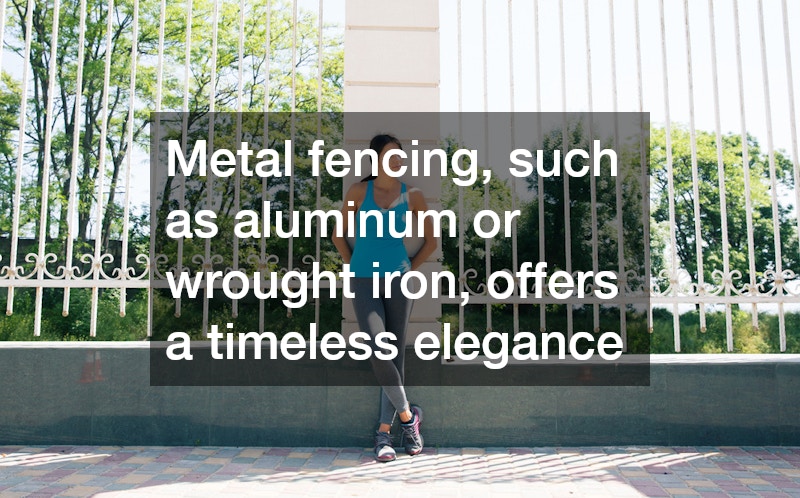There are a few essential factors to consider when choosing the perfect decorative fence for your property. Explore the various options, benefits, and styles that can enhance your outdoor space. With a multitude of styles and materials available, understanding your needs and preferences is crucial.
Additionally, the right decorative fence can significantly increase your property’s aesthetic appeal and value. Whether you reside in a busy city or a serene coastal area, the right fence can make all the difference.
Consider Your Options
The variety of decorative fences available today ensures that you can find something that fits your unique style and functional needs. Options can range from classic wooden picket fences to modern metal designs, giving homeowners a wide array to choose from. Additionally, decorative fencing can serve numerous purposes, including enhancing privacy, providing safety, and adding to curb appeal.
Some popular types of decorative fences include wrought iron, vinyl, composite, and wood. Each material has its own aesthetic and functional benefits. For instance, wrought iron boasts a traditional elegance and durability, while vinyl offers low maintenance and versatility. Understand the characteristics of these materials to make an informed choice.
When selecting a decorative fence, consider your home’s architecture and the overall landscape. A fence should complement the existing style of your property. The choice you make can create a cohesive look that enhances the beauty of your outdoor space, making it essential to align your fence selection with your home’s design.
Determine Fence Height
Determining the right height for your decorative fence is an important consideration that balances aesthetics and functionality. Generally, fences can range from 3 to 8 feet in height, depending on their intended use. For boundary marking, a lower fence may suffice, but for privacy or security purposes, a taller fence is often necessary.
Local zoning laws and neighborhood guidelines can dictate the maximum allowable height for residential fences. It’s advisable to check these regulations before making a purchase to avoid costly adjustments later. Additionally, consider how the height will affect the overall look of your yard, as a too-tall fence might overwhelm the landscape.
Height also plays a role in the level of privacy and protection provided. For instance, if you live in a densely populated area or near a busy street, opting for a taller decorative fence might be beneficial. Balancing these factors will help ensure that your fence meets both your decorative aspirations and practical requirements.
Choose the Right Materials
When selecting materials for your decorative fence, several options stand out based on durability, maintenance, and appearance. Wood is a classic choice that can be customized with stains or paint, but requires regular maintenance to prevent rot. On the other hand, vinyl fencing has gained popularity due to its resilience and ease of care, presenting a well-defined look.
Metal fencing, such as aluminum or wrought iron, offers a timeless elegance and security. These materials are often resistant to rust and corrosion, making them ideal for various climates. If you live in a more humid environment, a decorative metal fence can hold up well against the coastal humid air, provided proper coatings are applied.
Composite materials have also become an attractive option, as they combine the aesthetic appeal of wood with the durability of manufactured materials. By examining the pros and cons of each option, you will be better equipped to select the material that best meets your needs while enhancing the overall look of your outdoor area.
Maintain Your Fence
Proper maintenance of your decorative fence can prolong its lifespan and enhance its appearance. Each material has specific care requirements to keep it looking its best over the years. Wood fences, for example, typically need regular staining and sealing to protect against weather damage, while metal fences may require a periodic inspection for rust.
Vinyl fencing is generally low maintenance, but regular cleaning with soap and water can help maintain its appearance. Composite materials may also require less upkeep than traditional wood, but should still be checked for fading or wear over time. Adhering to these maintenance routines will ensure that your decorative fence remains aesthetically appealing.
Seasonal checks are essential, especially after severe weather events. Inspecting for any damage or wear enables prompt repairs, which will prevent larger issues later. By following maintenance guidelines and addressing issues as they arise, you can preserve your decorative fence for years of enjoyment.
Choosing the right decorative fence is crucial for enhancing the beauty and security of your property. By considering the types, height, materials, costs, and maintenance, you’ll be well on your way to creating your dream outdoor space. Whether you aim for artistic flair, practical privacy, or a combination of both, the perfect decorative fence awaits you. Don’t forget to explore local options to find the ideal fence that meets both your aesthetic and functional requirements.




